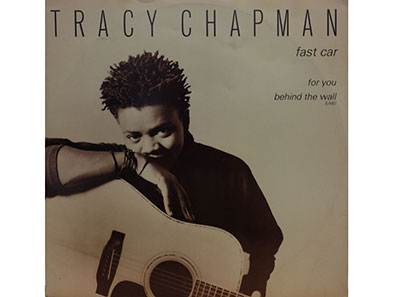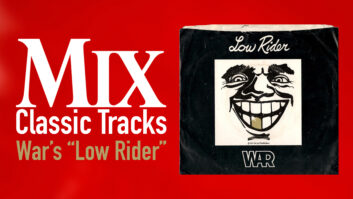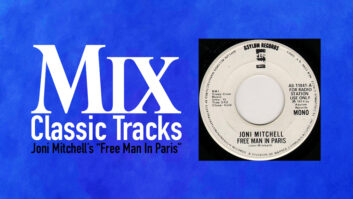
When stars align and the right producer hears an artist, gets excited and shares a vision—even helps shape that vision—magic is often the result. It sure worked with David Kershenbaum and Tracy Chapman in 1987.
Kershenbaum says it’s all about the emotional attachment a person makes to the art. And then the connection to the listener. For “Fast Car,” he said, the magic appeared as a combination of the relatable lyrics and Chapman’s unique voice.
“When you do it correctly, and the [the listener] makes that connection, they can tell you 20 years later who they were with, what they were wearing and when they heard the song because it’s such a powerful experience,” the producer says. “Out of everything I’ve done in my whole career, over decades, that song had the strongest emotional connection of any song I’ve ever done.”
Kershenbaum says Chapman had been playing around the Boston area when Brian Koppelman spotted her and brought her to his father, Charles Koppelman, who signed her to a publishing deal. Kershenbaum got a call from Don Rubin, who worked with Koppelman, asking if he would be interested in hearing a singer-songwriter they were working with.
After listening to the cassette of songs, Kershenbaum went to New York to meet with Chapman. “The second day we were going to have a meeting,” he recalls. “She said, ‘I have this new song I want to show you. I want to see what you think of it.’ It was ‘Fast Car’ on an acoustic guitar. I loved the song.”
A couple of weeks later, Chapman flew out to Los Angeles to work at Kershenbaum’s studio, Powertrax, the former Wally Heider Studio in Hollywood. Kershenbaum says he chose the musicians to work with her in a rather unorthodox way.
“I realized I wanted to do a very stripped-down, simplistic version, with her as the centerpiece, with her vocal out front,” he says. “In my past experience with singer-songwriters, if they play guitar and sing, they do the rhythm and chord changes and everything along with their vocals, but when you start to add musicians, it changes it. It was critical to have the right mix of players.”
Kershenbaum devised a way of finding that mix by putting Chapman’s vocal and guitar on a digital multitrack tape machine and invited different configurations of players in to play the track. “I said, ‘Look, you guys aren’t auditioning, I’m just trying to put together the right combination for a singer-songwriter who has never played with a band before,” he explains.
Five different bass players and five different drummers played along with her, and then for a couple of days he mixed and matched them to see what meshed the best.
“I kept doing that until I found the right combination, and that turned out to be Larry Klein, who was Joni Mitchell’s producer and ex-husband, on bass, and Denny Fongheiser on drums.”
They recorded live in the studio with Chapman in a vocal booth with her guitar, Klein patched directly in the control room, and Fongheiser in the big room with his drums.
“I would say 99.9 percent of the vocals were recorded live, as was her guitar,” Kershenbaum says. “The combination was very comfortable for her, and luckily she could play in time because she had never worked with a band before.”
Kershenbaum says that if she was nervous, she didn’t show it; but she was shy. “I think a lot of that vulnerability you hear was because of that,” he says. “She’s a very sweet girl and wonderful person.” And on that first record, he says, she mostly deferred to the wisdom of the experts. He recalls the album being completed in about four or five days, with three songs recorded per day.
“The little guitar line that starts ‘Fast Car,’ Tracy played that whole thing live,” Kershenbaum says. “Larry and Denny wrote their own charts. Denny would write the bars and figure out what his rhythm pattern would be and when he would play it, and Larry actually wrote down chords and notes. When we did it, they would follow those charts that were written in the studio.
“With Tracy there was a lot of feeling in the guitar and vocal, so I just enhanced that with the bass and drums, but constantly kept her up front,” he continues. “Throughout the whole process, I never added anything that I thought would detract from that.”
He used a Neumann TLM 49 on her vocal after trying several others. He says that he did add a little reverb and delay on Chapman’s vocal.
“That mic is an older vintage mic that has a characteristic of a lot of chest and upper bottom in the mic, and her voice is very rich in that area,” he says. “I wanted to make sure it wasn’t too bright and wasn’t too thin and had a lot of body to it. I felt that would also add to the impact of what she was singing and how she was singing.”
He is not sure exactly what mic he used on the guitar, but they used two. “Because I was recording the vocals live with the guitar, we put some cardboard or something on the top of the guitar in between the guitar and her voice to get the least amount of leakage possible,” he says.
At the time, for Powertrax, Kershenbaum had just purchased a Mitsubishi 850 32-track 16-bit digital recorder. “It was very high-tech and cutting-edge for the time,” he recalls. “The room itself had a vintage API console in it, which was from the days of Wally Heider and Hollywood Sound, so it was recorded digitally and then mixed to a digital 2-track. It was one of the early all-digital recordings. That gave it a lot of the clarity, which sounds okay today compared to other records you listen to recorded digitally.”
The record company wanted the chorus to come in sooner on the single “Fast Car,” and Kershenbaum tried to figure out how to do that, but to no avail.
“It had to be the way it was,” he says. “And I think it actually worked to the benefit of the record because it had so much more impact than bringing it in earlier.”
Part of that impact was the drum explosion on the chorus. “The way we got the drums to sound like that was with the room—it had a great sound,” he remembers. “And if you notice, there’s quite a bit of reverb on the drums so that when they hit, they really have a lot of power. And then the rest of it was the way Denny played it. Kevin Smith did some wonderful recording of the drums and Denny is a genius. He didn’t step on Tracy on any of the songs. He offered just the right amount of rhythmic support without getting in the way and dynamically came forward when it was his moment in the arrangement.”
When it came time to mix, there was no automation back then. Kershenbaum mixed Chapman’s vocal up front.
“Because I had a digital recorder and there was no loss of going to another generation like you would in analog, I mixed to 2-tracks on the digital recorder,” he explains. “That allowed me to punch in the mix. So let’s suppose I did the first verse and I had that over on the 2-track of the digital recorder and I thought I miswrote some vocal lines and I would like to rewrite them again on the vocal track, I could just play the track, hit record just like I would punch in an artist or musician and make my ride and punch out and it was seamless. I went through the mixes and did them that way. In the older days of analog, the only way you could do that was to mix sections to tape and then cut the tape together, but if you happened to hit a fader and the balance wasn’t exactly the same between the two sections you were cutting together, it could be a nightmare.
“This was great. There was no automation, but in a sense it was kind of that way because it allowed me to do a lot of things I couldn’t have done if I were just mixing from top to bottom, live to a 2-track.”
Chapman’s self-titled debut album went to Number One on the Billboard charts, with “Fast Car” hitting Number Six on the singles charts.







